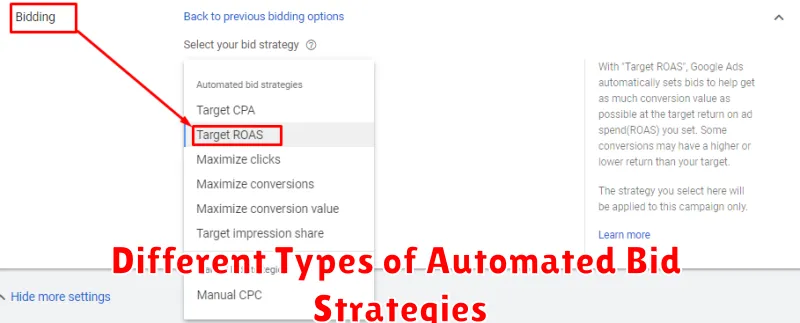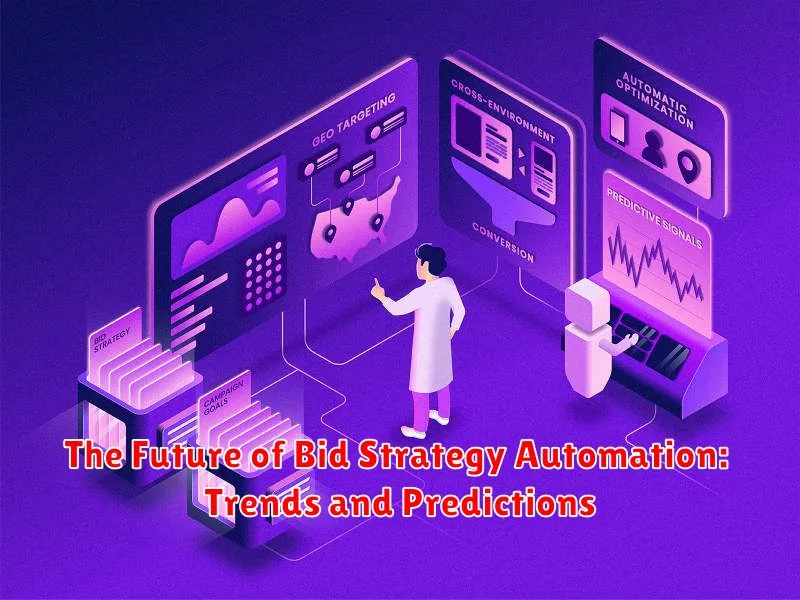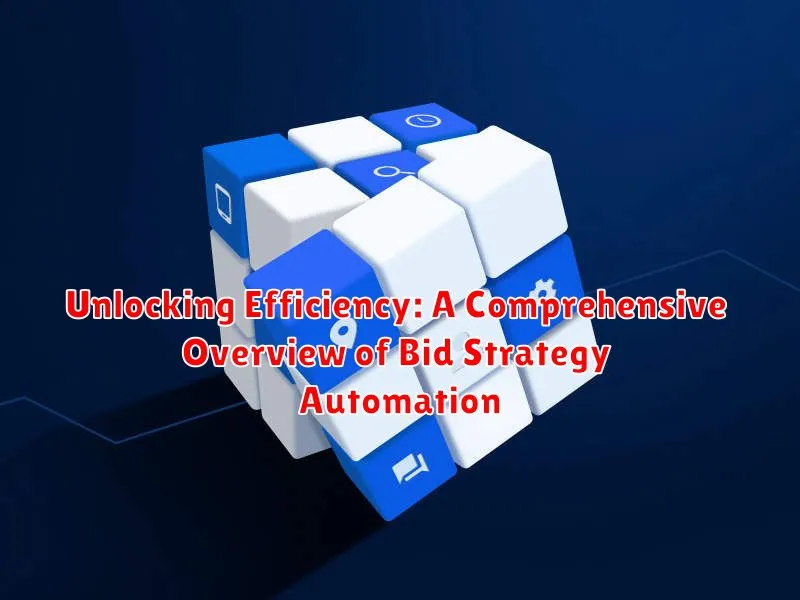In today’s rapidly evolving digital marketing landscape, achieving optimal campaign performance requires sophisticated strategies and efficient execution. Bid strategy automation has emerged as a critical tool for marketers seeking to maximize return on ad spend (ROAS) and streamline their workflow. This comprehensive overview will delve into the core principles of bid strategy automation, examining its various types, benefits, and the essential considerations for successful implementation across platforms like Google Ads and other programmatic advertising ecosystems. Understanding and leveraging these automated solutions is no longer a luxury, but a necessity for staying competitive in the global market.
This article aims to provide a detailed exploration of unlocking efficiency through bid strategy automation. We will cover key aspects such as defining suitable key performance indicators (KPIs), selecting the appropriate automation strategy (e.g., target CPA, target ROAS, maximize conversions), and monitoring performance to ensure alignment with business objectives. Furthermore, we will discuss the integration of bid automation with other marketing technologies and best practices for adapting to the ever-changing advertising landscape. Whether you are a seasoned marketing professional or new to the world of paid advertising, this guide will equip you with the knowledge to harness the power of bid strategy automation for improved results.
What is Bid Strategy Automation and Why is it Important?
Bid strategy automation refers to the process of using software and algorithms to automatically manage and optimize bids in online advertising campaigns. Instead of manually adjusting bids based on performance data, automated systems analyze real-time information and make adjustments to maximize return on investment (ROI).
The importance of bid strategy automation lies in its ability to:
- Improve efficiency: Automate repetitive tasks, freeing up marketers’ time for strategic initiatives.
- Enhance performance: Leverage data-driven insights to make more informed bidding decisions.
- Increase ROI: Optimize bids to maximize conversions and revenue.
- Scale campaigns effectively: Manage large and complex campaigns with ease.
- React to market changes quickly: Adjust bids in real-time to changing market conditions.
By implementing bid strategy automation, businesses can gain a significant competitive advantage in the digital advertising landscape.
Key Components of Effective Bid Strategy Automation
Effective bid strategy automation relies on several key components working in synergy to achieve optimal results. A solid foundation is crucial for success.
Data-Driven Insights
The bedrock of any successful automated bidding strategy is data. This encompasses historical campaign performance, website analytics, and market trends. Quality data informs algorithms and ensures bids are aligned with user behavior and conversion probabilities.
Algorithm Selection
Choosing the right algorithm is paramount. Different algorithms cater to various campaign goals, such as maximizing conversions, increasing brand awareness, or achieving a target cost per acquisition (CPA).
Real-Time Monitoring and Adjustment
Continuous monitoring of campaign performance is essential. Automated systems should be equipped to make real-time adjustments to bids based on performance data and predefined rules. This responsiveness ensures campaigns remain optimized and aligned with objectives.
Benefits of Implementing Automated Bidding Strategies
Implementing automated bidding strategies offers numerous advantages for digital marketing campaigns. Perhaps the most significant benefit is the substantial time savings. By automating the bidding process, marketers can free up valuable time to focus on other critical aspects of campaign management, such as creative development and audience targeting.
Furthermore, automated bidding often leads to improved campaign performance. These systems can analyze vast amounts of data in real-time, identifying patterns and trends that would be impossible for humans to detect manually. This data-driven approach allows for more precise bid adjustments, resulting in increased conversion rates and a lower cost per acquisition (CPA).
Another key benefit is enhanced scalability. Automated bidding systems can efficiently manage large and complex campaigns with ease, making it possible to scale marketing efforts without requiring additional manpower. This scalability is particularly valuable for businesses experiencing rapid growth or managing multiple campaigns across different platforms.
Different Types of Automated Bid Strategies

Automated bid strategies in digital advertising offer a range of approaches designed to optimize campaign performance. These strategies can be broadly categorized based on their primary goals and algorithmic methodologies.
Target CPA (Cost Per Acquisition)
This strategy focuses on achieving a desired cost per conversion. The system automatically adjusts bids to maximize conversions while staying within the target CPA.
Target ROAS (Return on Ad Spend)
Target ROAS aims to generate a specific return on ad spend. Bids are adjusted to maximize revenue relative to advertising costs.
Maximize Clicks
This strategy prioritizes driving as much traffic as possible within a given budget. The system automatically sets bids to achieve the highest number of clicks.
Maximize Conversions
Maximize Conversions focuses on obtaining the greatest number of conversions within a defined budget, without a specific CPA target.
Target Impression Share
This strategy strives to achieve a desired percentage of impressions for specific keywords or campaigns, increasing visibility.
Enhanced CPC (ECPC)
A semi-automated approach, ECPC adjusts manual bids to increase conversions. It raises bids for clicks that seem more likely to convert and lowers them for less promising clicks.
How to Set Up and Manage Automated Bidding Campaigns
Establishing and maintaining automated bidding campaigns requires a structured approach. The initial step involves selecting the appropriate bidding strategy based on your campaign goals, such as maximizing conversions or increasing brand awareness.
Next, define your target audience and set relevant conversion tracking to accurately measure performance. Configure your campaign settings, including budget, location targeting, and ad scheduling. Regularly monitor your campaign’s performance metrics, such as cost per acquisition (CPA) and return on ad spend (ROAS), to identify areas for improvement.
A/B test different ad creatives and landing pages to optimize your conversion rates. Adjust your bidding strategy based on performance data and market trends. Utilize reporting tools to gain insights into campaign performance and identify potential issues. Continuously refine your campaign settings to ensure optimal performance and alignment with your business objectives.
Common Challenges and Solutions in Bid Strategy Automation
Implementing bid strategy automation, while offering significant advantages, presents unique challenges. One common issue is data scarcity, particularly for new campaigns or niche markets. Without sufficient historical data, automated systems may struggle to make informed bidding decisions. A solution involves leveraging broader audience targeting initially to gather data more quickly, followed by refining targeting as data accumulates.
Another challenge is algorithm complexity. Understanding how algorithms operate and diagnosing issues can be difficult. Strategies to address this include thorough testing of different bid strategies and continually monitoring campaign performance metrics.
Over-reliance on automation is also a potential pitfall. While automation is powerful, it’s crucial to maintain human oversight. Regular review of campaign settings, ad copy, and landing page performance is essential to ensure that automated systems are aligning with business objectives. Consider A/B testing to evaluate the effectiveness of different strategies.
Finally, keyword cannibalization can occur when automated systems compete against each other for the same keywords. Implementing a negative keyword strategy can prevent this.
Integrating Machine Learning for Enhanced Bid Optimization
Machine learning (ML) has become increasingly vital in bid optimization. Its capacity to analyze vast datasets and identify patterns surpasses traditional rule-based systems. By leveraging ML, advertisers can dynamically adjust bids based on real-time data and predicted outcomes.
Here are key aspects of integrating ML:
- Predictive Modeling: ML algorithms predict conversion rates, click-through rates, and customer lifetime value, enabling precise bid adjustments.
- Automated A/B Testing: ML automates the testing of different bid strategies, identifying optimal approaches for various audience segments.
- Real-Time Optimization: ML models continuously learn and adapt to changing market conditions, ensuring bids remain competitive and efficient.
The use of ML not only enhances bidding efficiency but also reduces the manual effort required for campaign management, freeing up resources for strategic initiatives.
Measuring the Success of Your Automated Bid Strategies
Measuring the success of your automated bid strategies is crucial for understanding their effectiveness and making data-driven adjustments. This involves tracking key performance indicators (KPIs) and analyzing the overall impact on your advertising goals.
Key Performance Indicators (KPIs) to Monitor
- Conversion Rate: Track the percentage of clicks that result in desired actions, such as purchases or sign-ups.
- Cost Per Acquisition (CPA): Monitor the cost associated with acquiring a new customer or lead.
- Return on Ad Spend (ROAS): Calculate the revenue generated for every dollar spent on advertising.
- Click-Through Rate (CTR): Analyze the percentage of impressions that result in clicks.
- Impression Share: Understand the percentage of times your ads are shown when they are eligible.
Tools and Techniques for Measurement
Utilize analytics platforms like Google Analytics and the built-in reporting tools of your advertising platforms (e.g., Google Ads, Facebook Ads Manager). A/B testing different bid strategies can also provide valuable insights.
Analyzing the Data
Regularly review your KPIs to identify trends and areas for improvement. Compare performance against your initial goals and benchmarks. Use this data to refine your bid strategies and optimize your campaigns for better results. Remember that continuous monitoring and optimization are essential for maximizing the benefits of automated bidding.
The Future of Bid Strategy Automation: Trends and Predictions

The realm of bid strategy automation is rapidly evolving, driven by advancements in artificial intelligence (AI) and machine learning (ML). We anticipate increased sophistication in algorithmic bidding, moving beyond simple rule-based systems to more nuanced, predictive models. These models will leverage deeper data insights to understand user behavior and market dynamics with greater accuracy.
One key trend is the growing importance of predictive analytics. Automated systems will increasingly forecast future performance, enabling proactive adjustments to bidding strategies. This will involve analyzing historical data, seasonality, and external factors to optimize bids in real-time.
Personalization at scale is another significant trend. Bid strategies will become more granular, targeting individual users or segments with tailored bids based on their unique characteristics and preferences. This will require sophisticated data management and privacy compliance.
Finally, expect greater integration across platforms and channels. Automated bidding will extend beyond traditional search and display advertising to encompass emerging channels like connected TV (CTV) and digital out-of-home (DOOH), providing a unified approach to media buying.

